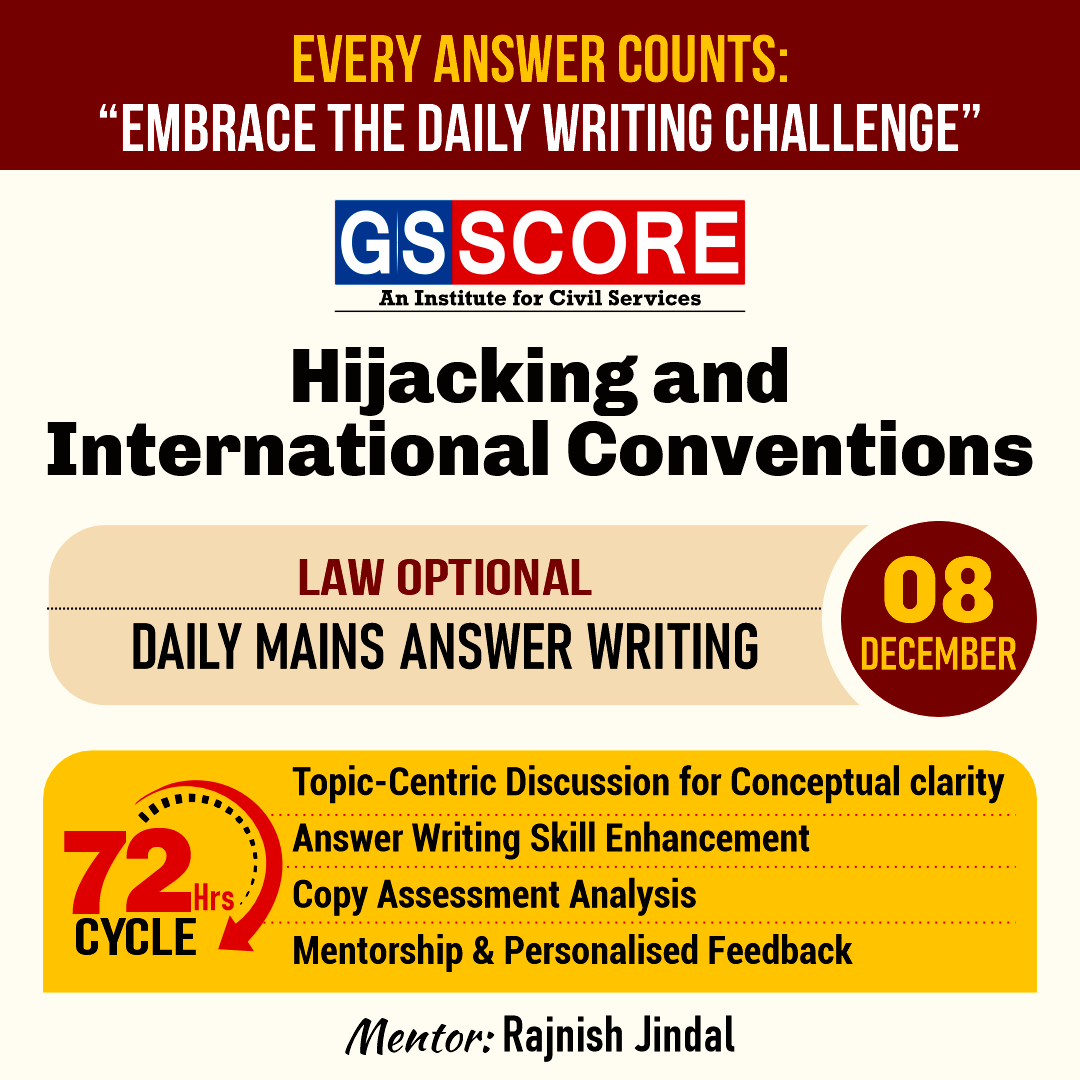


Instruction:
- There will be 2 questions carrying the First Question is-10 marks Write your answers in 150 words and the Second Question is-15 marks Write your answers in 250 words.
- Any page left blank in the answer-book must be crossed out clearly.
- Evaluated Copy will be re-uploaded on the same thread after 2 days of uploading the copy.
- Discussion of the question and one to one answer improvement session of evaluated copies will be conducted through Google Meet with concerned faculty. You will be informed via mail or SMS for the discussion.
Question #1. Define ‘hijacking’ and discuss the main provisions of the Tokyo Convention, 1963. 10 marks (150 words)
Question #2. Write a short note on the applicable laws in India relating to aircraft hijacking. 15 marks (250 words)
(Examiner will pay special attention to the candidate's grasp of his/her material, its relevance to the subject chosen, and to his/ her ability to think constructively and to present his/her ideas concisely, logically and effectively).
STEPS & INSTRUCTIONS for uploading the answers
Step 1 - The Question for the day is provided below these instructions. It will be available at 7:00 AM.
Step 2 - Uploading of Answers : Write the answer in A4 Sheet leaving proper margins for comments and feedback and upload the PDF in MY ACCOUNT section. Click on the option of SUBMIT COPY to upload the PDF.
Step 3 - Deadline for Uploading Answers: The students shall upload their answers by 7:00 PM in the evening same day. The first 50 copies will be evaluated.
Step 4 - Feedback : Mentors will give their feedback for the answers uploaded. For more personalised feedback, join our telegram channel by clicking on the link https://t.me/mains_answer_writing_cse . A one-to-one session will be conducted with the faculty after copy evaluation in 72 Hrs.
Model Answer
Question #1. Define ‘hijacking’ and discuss the main provisions of the Tokyo Convention, 1963. 10 marks (150 words)
Aircraft hijacking is the unlawful seizure of an aircraft by an individual or a group.
According to Alone E. Evans, aircraft hijacking is a contemporary addition to the roster of international and national crimes and the necessity for its control at international and national level is only beginning to be recognized by the States.
The increase in the number of incidents of hijacking and increase in the dangers against the safety of the flights of aircrafts presents grave problems before the international community and particularly before the International Civil Aviation Organization. In order to solve this problem and punish the hijackers several Conventions have been adopted.
The Tokyo Convention, 1963: The Convention on Offences and Certain Other Acts Committed on Board Aircraft was signed at Tokyo in a diplomatic conference on September 14, 1963. It came into force on December 4, 1969.
The Tokyo Convention as stipulated under Article 1 Clause (1) covers: Offences against penal law; Acts which, whether or not they are offences, may or do jeopardize good order and discipline on board.
The applicability of this Convention has been elaborated in Article 1 Clause (2) which provides that: “The Convention shall apply in respect of offences committed or acts done by a person on board any aircraft registered in a Contracting State, while that aircraft is in flight or on the surface of the high seas or of any other areas outside the territory of any State.”
The Convention forbids forceful seizure of civil aircraft in flight and as in Article 11, charges the Contracting States with the duty of restoring such aircraft and cargo to the rightful owners and facilitating resumption of the interrupted flight.
The Tokyo Convention suffers from a number of deficiencies.
- The convention neither defines the term hijacking nor makes an effort to deal with an offence itself presumably because the act of hijacking was not regarded as a crime. It simply lays down what would be the consequences if hijacking takes place.
- The Convention does not extend to domestic airlines (except when the airlines pass over the high seas but linking cities of the State of registration).
- There is an absence of the provision regarding clearly formulated principle of inescapable punishment. There is no prescription of adequate punitive measures. The main emphasis is on restoration of property and resumption of flight. The offender may be taken into custody by the Contracting State which may initiate criminal proceeding or extradite the offender, but neither action is mandatory. Article 16 makes it clear that it does not create an obligation to grant extradition.
- Exclusive rights given to flight commanders for protecting the aircraft and imposing restraints on the offenders are to some extent unjustifiable.
Question #2. Write a short note on the applicable laws in India relating to aircraft hijacking. 15 marks (250 words)
The hijacking of Indian Airlines flight IC-814 in 1999 and the 9/11 attacks in the U.S., in which aircraft were used as missiles, were wake-up calls for India to tighten the 1982 vintage anti-hijacking law. The need was also felt to make hijacking punishable with the death penalty.
The government felt that the Anti-Hijacking Act of 1982 had insufficient penalties and was not comprehensive enough to deal with new challenges. In fact, it was hardly a deterrent for prospective offenders.
The Anti-Hijacking Act, 2016 repealed the 1982 Act. Its objectives are in tune with the Convention for the Suppression of Unlawful Seizure of Aircraft. The Act further incorporated the September 2010 Beijing Protocol Supplementary to the Convention which specifically dealt with “unlawful acts against civil aviation by new types of threats”. The Act highlighted the government’s concern for expedient measures to be taken during hostile acts of seizure or exercise of control of aircraft which jeopardise the safety of persons and property.
The new law revamped Section 3 of the 1982 legislation to expand the definition of hijacking to seizure or take over of an aircraft using “any technological means”. This takes into consideration the possibility that a hijacker need not be physically present inside the aircraft to take control of it. The aim of the act is to broaden the scope of the term ‘hijacking’ by including in its definition even the making of a threat to commit an offence of hijacking. It is now also an offence to unlawfully and intentionally cause any person to receive a threat under circumstances that indicate that the threat is credible.
According to the Act, even a credible “threat” to hijack an aircraft amounts to hijacking. The definition of ‘hijacking’ also includes an attempt to commit the crime, abetting, organising, participating in it as an accomplice, and unlawfully and intentionally assisting a person involved in hijacking to evade investigation or prosecution or punishment. Here, a person who does not actually participate in the hijacking but “directs” someone else to do it is equally liable.
Section 4 allows capital punishment if the hijacking leads to the death of a hostage, a security personnel, or any person not involved in the offence. The alternative is life imprisonment. The Act makes it clear that imprisonment for life means “imprisonment for the remainder of that person’s natural life”. There is no chance of remission.
An aircraft is considered to be “in-service” from the beginning of its pre-flight preparation by ground personnel or crew for a specific flight until 24 hours after “any landing”. Further, in case of a forced landing, the flight is deemed to continue in service until the competent authorities take over responsibility of the aircraft, and for the persons and property on board.
The change of Jurisdiction of law is one more important amendment. Section 7 of the Act says, the provisions now deal with the Indian hijackers hijacking aircraft within or outside the territory of India or hijacking aircraft which has Indian registration and has Indian passengers in a foreign plane with the offenders. So under all these circumstances, the Act is applicable.
In the case of Birju Kishore Kumar Salla vs State Of Gujarat (2018), the court found Mr Salla guilty under the Anti-Hijacking Act, 2016 because he left a threatening note in the aircraft of Jet airways for his personal and bizarre reasons, where he thought that by leaving a threat note in the washroom of the aircraft, the Jet Airways will be shut down and furtherance to this he anticipated that his girlfriend will come back to him in Mumbai, for which he was held liable and now he is serving his life imprisonment in jail and was also asked to pay five crores as the fine amount. Though his intentions were not to technically hijack the aircraft or hurt anyone but even leaving a threat note come under the unlawful act and so he was held liable.


